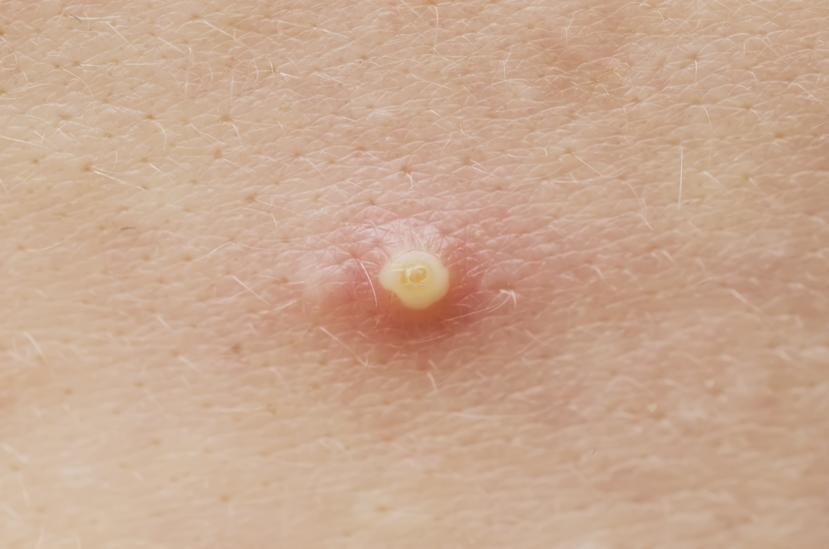How to Get Rid of a Boil: Homeopathic Treatment and Prevention

Introduction
A small bump on any part of the body is always a troublesome affair. Has anyone wondered whether it is just a boil or a pimple? Although the two often look so similar, they are actually two different things. A pimple and a boil may start out similarly, wherein there would be a reddish raised spot on the skin.
In the case of a boil, it tends to grow larger and also becomes worse as time passes. In certain instances, a boil can grow larger to a size of a golf ball. It is obvious that no one would want that boil on their body whether it causes pain or not. Hence, it is important to get rid of boils and try as much as possible to prevent them from occurring.
What is a boil?
In medical terms, a boil is also called as a furuncle. It is a type of skin infection, which is usually caused by bacteria. A boil can be characterized as an extreme case of a pimple. A boil is a raised red bump, which can be painful and swollen.
A boil usually forms when there is a bacterial infection of the hair follicle or oil gland. Pus is formed when bacteria start to grow, causing the boil to balloon outward with a liquid-filled center. Boils usually form in areas where there are sweat and friction such as the buttocks and armpits.
Boils are known to be caused by a very common bacteria called Staphylococcus aureus. This particular bacterium is one among the other 30 types of Staphylococcus. It is also commonly called as "staph". There can be other fungi or bacteria, which can lead to the formation of boils. However, staph is the most common causative agent of boils. The bacterium can enter the body via skin cuts, wounds, or it can move down to the hair follicles. A boil can also be called as a type of abscess, which can be painful. The formation of pus is caused by bacterial infection.
A boil is round in shape and is raised from the surface of the skin. As it grows, it becomes painful to the slightest touch. When it appears, the skin in that area turns pinkish red and a small bump starts to form from the surface of the skin. After a few days, the boil starts to turn white in color due to pus under the skin.
Avoid popping the boil since it can lead to the spread of infection to other areas of the body. Most of the time, boils tend to occur in the hair follicles present anywhere in the body, but the most common areas can be the neck, thighs, buttocks, face, and armpits. Moreover, boils tend to get very painful in these areas.
How to get rid of a boil?
Usually, a small boil will drain out on its own within a span of two weeks in most healthy individuals. One of the best treatments, which can be done to get rid of boils is to leave it as it is without popping it. If the boil is left on its own, it will most likely break and drain on its own within two weeks.
Popping a boil using your fingers or with the help of a needle or pin can worsen the infection. Remember not to squeeze, open, or scratch the boil. If you try to squeeze the boil, it would actually push the infection deeper inside the skin instead of letting the boil heal on its own.
Below are easy and natural options that can help get rid of boils at home:
1. Maintain a Good Hygiene
Stay away from antibacterial soaps and creams once you have a boil since they are not beneficial for the healing of boils. An overuse of these antibacterial soaps can instead lead to antibacterial overkill.
What you can do instead is to gently wash the affected skin area with mild soap and water. Carry out this practice two to three times a day. You can then apply warm compresses on the boil area and keep it for 15-20 minutes. This can also be done around three to four times a day. Doing this routine as well as warm compresses would lead to the natural draining of the boil without any kind of pressure.
Once the boil opens and starts to drain on its own, you can continue doing heat compresses for three to four days after the opening of the boil. Slowly wash the affected area with water and antibacterial soap, especially the one that contains tea tree oil. Later, you can apply a natural antibiotic ointment which is available in health stores and get it bandaged. When you tie the bandage around the affected area, ensure that it is not too tight to allow the air to flow through to the affected area. Also, ensure to get the bandage changed every day after cleaning the area. When using an antibacterial soap, avoid those commercial ones.
The US Food and Drug Administration also recommends that regular soap and water works best for cleaning the boil area. It works the same when using antibacterial soap, but without causing any side effects or worsening the condition.
Another method of maintaining hygiene is to bathe on a regular basis. Avoid sharing your towels or washcloths to prevent the spread of infection. Do not have any close contact with someone who already has a boil or staph infection.
2. Reduce Sugar Intake
Diet plays an important role in the formation of boils and their healing. Reducing your sugar consumption can help reduce the risk of having boils.
For those who have boils or those who suffer from recurrent boils should consider cutting down their sugar intake since this type of infection tends to occur mostly in individuals who consume larger amounts of sugary foods and beverages. Hence, try to minimize consuming foods that are high in sugar to prevent and heal boils faster.
Apart from preventing boils, cutting out sugar also has a positive impact on your overall health since excessive sugar consumption is often linked to serious health problems.
3. Turmeric
Turmeric is a common household spice, which is also considered as a natural blood purifier. It contains anti-inflammatory properties, which are quite beneficial when it comes to the treatment of boils.
You can mix a spoon of turmeric in a glass of warm milk and stir it well. Consume this herbal mixture at least three times a day. You can also use turmeric with fresh ginger for added benefits. Make a fresh ginger paste and mix it with turmeric. Apply this mixed paste directly on the boil and see how it naturally heals the boil.
4. Eucalyptus Oil
This oil is also helpful and acts as a natural remedy for boils. You would need to prepare a mixture by mixing 2-3 drops of eucalyptus oil with 30 grams of powdered slippery elm. Add the mixture to boiling water to make a thick paste out of it. Apply this paste directly on the boil until the boil opens and drains out the pus. Do this process several times a day for faster healing.
5. Garlic
Garlic is also loaded with antibacterial properties, which makes it suitable for the natural treatment of boils. Make a paste of freshly ground garlic cloves. This paste can then be applied directly on the boil.
6. Milk
Milk has been considered as one of the traditional remedies for the treatment of boils. You can heat a cup of milk and add around two to three teaspoons of salt to it. Stir this mixture thoroughly to properly dissolve the salt. Next, add some bread crumbs to thicken the mixture. If bread crumbs are unavailable, you can use flour instead. Apply this thick mixture directly on the boil or the affected area. Repeat this procedure several times a day for added benefits and quick healing of the boil.
Milk cream is also regarded as beneficial for healing boils. Combine a teaspoon of milk cream, turmeric powder, and vinegar. Mix it well to form a paste. Apply this paste directly on the boil.
Taking Care of the Wound
For the prevention of boils, it is quite important to ensure that you clean any kind of skin cuts, wounds, or scratches. Most of the time, a scratch is not serious but you should also not ignore it since it can also become serious if proper care is not taken. A small opening or scratch is a wound that can become an easy entrance for bacteria to enter the body, especially if one comes in direct skin contact with someone who has a boil. Hence, ensure to clean wounds or scratches to keep infection at bay.
Homeopathic Treatment
Homeopathic treatment is also considered as one of the best methods in the treatment of boils at home. There is a long list of homeopathic medicines that can be used for the treatment of boils. Two of the best treatments are:
- Hepar Sulphuris Calcareum: This homeopathic medicine is known for speeding up the process of pus collection in the boil. It is mostly taken so that the boil opens soon and drains out the inside filling along with a faster healing process.
- Belladonna: Belladonna can be taken in the initial stages of inflammation before the boil has any significant formation of pus. It can be taken when the infected region is not too hot, tender, or throbbing with pain. You may also feel feverish or feel excited all of a sudden after taking this medicine.
Apart from the above remedies, other recommended homeopathic medicines include mercurius solubilis, silica, calendula, and arsenicum album. However, not all of these medicines would work in the same manner for all individuals. It is better to consult a homeopathic doctor to get an appropriate prescription.
Antibiotic Treatment
Apart from natural and homeopathic remedies, there are also antibiotics for the treatment of boils. They include:
- Ichthammol Ointment: This antibiotic is mostly known for curing a number of health problems such as removing splinters, treating insect bites, poison ivy rash, and boils.
- Neosporin: This antibiotic can be directly applied to the affected region as well as its surrounding area. The use of this medicine can help in the faster treatment of boils.















